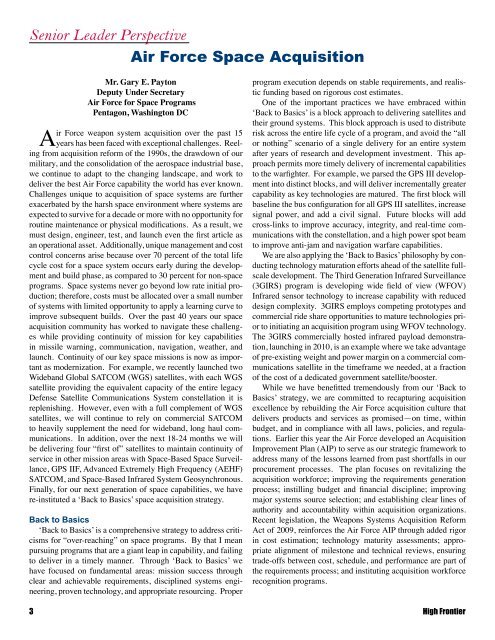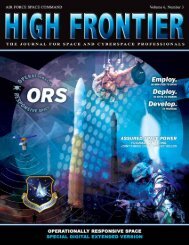Space Acquisition - Air Force Space Command
Space Acquisition - Air Force Space Command
Space Acquisition - Air Force Space Command
You also want an ePaper? Increase the reach of your titles
YUMPU automatically turns print PDFs into web optimized ePapers that Google loves.
Senior Leader Perspective<br />
<strong>Air</strong> <strong>Force</strong> <strong>Space</strong> <strong>Acquisition</strong><br />
Mr. Gary E. Payton<br />
Deputy Under Secretary<br />
<strong>Air</strong> <strong>Force</strong> for <strong>Space</strong> Programs<br />
Pentagon, Washington DC<br />
<strong>Air</strong> <strong>Force</strong> weapon system acquisition over the past 15<br />
years has been faced with exceptional challenges. Reeling<br />
from acquisition reform of the 1990s, the drawdown of our<br />
military, and the consolidation of the aerospace industrial base,<br />
we continue to adapt to the changing landscape, and work to<br />
deliver the best <strong>Air</strong> <strong>Force</strong> capability the world has ever known.<br />
Challenges unique to acquisition of space systems are further<br />
exacerbated by the harsh space environment where systems are<br />
expected to survive for a decade or more with no opportunity for<br />
routine maintenance or physical modifications. As a result, we<br />
must design, engineer, test, and launch even the first article as<br />
an operational asset. Additionally, unique management and cost<br />
control concerns arise because over 70 percent of the total life<br />
cycle cost for a space system occurs early during the development<br />
and build phase, as compared to 30 percent for non-space<br />
programs. <strong>Space</strong> systems never go beyond low rate initial production;<br />
therefore, costs must be allocated over a small number<br />
of systems with limited opportunity to apply a learning curve to<br />
improve subsequent builds. Over the past 40 years our space<br />
acquisition community has worked to navigate these challenges<br />
while providing continuity of mission for key capabilities<br />
in missile warning, communication, navigation, weather, and<br />
launch. Continuity of our key space missions is now as important<br />
as modernization. For example, we recently launched two<br />
Wideband Global SATCOM (WGS) satellites, with each WGS<br />
satellite providing the equivalent capacity of the entire legacy<br />
Defense Satellite Communications System constellation it is<br />
replenishing. However, even with a full complement of WGS<br />
satellites, we will continue to rely on commercial SATCOM<br />
to heavily supplement the need for wideband, long haul communications.<br />
In addition, over the next 18-24 months we will<br />
be delivering four “first of” satellites to maintain continuity of<br />
service in other mission areas with <strong>Space</strong>-Based <strong>Space</strong> Surveillance,<br />
GPS IIF, Advanced Extremely High Frequency (AEHF)<br />
SATCOM, and <strong>Space</strong>-Based Infrared System Geosynchronous.<br />
Finally, for our next generation of space capabilities, we have<br />
re-instituted a ‘Back to Basics’ space acquisition strategy.<br />
Back to Basics<br />
‘Back to Basics’ is a comprehensive strategy to address criticisms<br />
for “over-reaching” on space programs. By that I mean<br />
pursuing programs that are a giant leap in capability, and failing<br />
to deliver in a timely manner. Through ‘Back to Basics’ we<br />
have focused on fundamental areas: mission success through<br />
clear and achievable requirements, disciplined systems engineering,<br />
proven technology, and appropriate resourcing. Proper<br />
program execution depends on stable requirements, and realistic<br />
funding based on rigorous cost estimates.<br />
One of the important practices we have embraced within<br />
‘Back to Basics’ is a block approach to delivering satellites and<br />
their ground systems. This block approach is used to distribute<br />
risk across the entire life cycle of a program, and avoid the “all<br />
or nothing” scenario of a single delivery for an entire system<br />
after years of research and development investment. This approach<br />
permits more timely delivery of incremental capabilities<br />
to the warfighter. For example, we parsed the GPS III development<br />
into distinct blocks, and will deliver incrementally greater<br />
capability as key technologies are matured. The first block will<br />
baseline the bus configuration for all GPS III satellites, increase<br />
signal power, and add a civil signal. Future blocks will add<br />
cross-links to improve accuracy, integrity, and real-time communications<br />
with the constellation, and a high power spot beam<br />
to improve anti-jam and navigation warfare capabilities.<br />
We are also applying the ‘Back to Basics’ philosophy by conducting<br />
technology maturation efforts ahead of the satellite fullscale<br />
development. The Third Generation Infrared Surveillance<br />
(3GIRS) program is developing wide field of view (WFOV)<br />
Infrared sensor technology to increase capability with reduced<br />
design complexity. 3GIRS employs competing prototypes and<br />
commercial ride share opportunities to mature technologies prior<br />
to initiating an acquisition program using WFOV technology.<br />
The 3GIRS commercially hosted infrared payload demonstration,<br />
launching in 2010, is an example where we take advantage<br />
of pre-existing weight and power margin on a commercial communications<br />
satellite in the timeframe we needed, at a fraction<br />
of the cost of a dedicated government satellite/booster.<br />
While we have benefitted tremendously from our ‘Back to<br />
Basics’ strategy, we are committed to recapturing acquisition<br />
excellence by rebuilding the <strong>Air</strong> <strong>Force</strong> acquisition culture that<br />
delivers products and services as promised—on time, within<br />
budget, and in compliance with all laws, policies, and regulations.<br />
Earlier this year the <strong>Air</strong> <strong>Force</strong> developed an <strong>Acquisition</strong><br />
Improvement Plan (AIP) to serve as our strategic framework to<br />
address many of the lessons learned from past shortfalls in our<br />
procurement processes. The plan focuses on revitalizing the<br />
acquisition workforce; improving the requirements generation<br />
process; instilling budget and financial discipline; improving<br />
major systems source selection; and establishing clear lines of<br />
authority and accountability within acquisition organizations.<br />
Recent legislation, the Weapons Systems <strong>Acquisition</strong> Reform<br />
Act of 2009, reinforces the <strong>Air</strong> <strong>Force</strong> AIP through added rigor<br />
in cost estimation; technology maturity assessments; appropriate<br />
alignment of milestone and technical reviews, ensuring<br />
trade-offs between cost, schedule, and performance are part of<br />
the requirements process; and instituting acquisition workforce<br />
recognition programs.<br />
3 High Frontier











